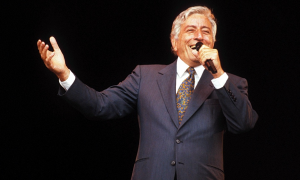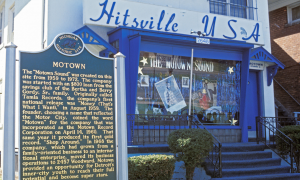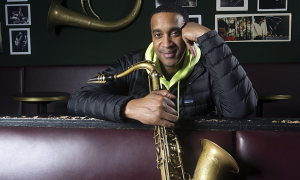Home » Jazz Articles » Beauty, Love and Justice: Living A Coltranian Life » Harry Belafonte: Humanitarian, Social Justice Leader and...
Harry Belafonte: Humanitarian, Social Justice Leader and Artist Extraordinaire

Courtesy Panther Media GmbH
Artists are the gatekeepers of truth.
—Paul Robeson
Destiny
Not many people from my old neighborhood of Old Mill Basin, Brooklyn get to go to the movies with Harry Belafonte, but I did. It was a September evening in 2015 and I went to see The Black Panthers: Vanguard of the Revolution at the Film Forum with philosopher Dr. Cornel West, and his friends Harry and Pam Belafonte. We dined with Mr. Belafonte on a number of occasions prior, went to his office, and visited his beautiful Upper Westside Manhattan apartment. On this evening sharing popcorn with these activists left me with the epiphany that absorbing the energy in the room was part of my hero's journey as an educator and a writer. I am introverted according to a Myers—Briggs personality assessment, but I am always paying attention. I remember traveling in a car with Harry Belafonte and Cornel West and listening more than sharing my thoughts with them. Harry asked me a question connected to social justice, and I remember paraphrasing some of the ideas I learned from reading Martin and Malcolm, which I felt deeply. The first time we had dinner at a fine Italian restaurant across from the American Museum of Natural History, it felt like an out-of-body experience. Harry gave me his attention and so I shared an overview of my Kids for Coltrane curriculum and why I think teaching through the arts is important. He smiled. It seemed to me that Harry had an extra sense through his long-lived experience to assess who spoke experienced and honest truth. I felt accepted in his presence. He also knew I am sure that he was majestic, not because he was the famous Harry Belafonte movie star, singer, and social justice activist who was with Martin Luther King, but because he has a kingly stature. If humanity has inherent royalty, then for sure Harry Belafonte looms with a purple aurora, he shines like a true prince amongst men.John Coltrane, a spirit guide to me, often shared his understanding of vibrations. "God breathes through us so completely so greatly we scarcely feel it-yet it is our everything." I can affirm when being in Harry Belafonte's presence the energy is dazzling.
The memory of sitting in that movie theater sharing popcorn with my famed friends, with members of the original Black Panthers in the audience, and other innovative leaders of industries and social causes moved me and offered more evidence to my soul that I was on the path of a lifetime, my own path. Joseph Campbell has said, "The honor of a lifetime is living the life you were meant to live." If I was ever not sure, I was sure then, and there would be no turning back from the exhilaration, freedom, and purpose.
Having a sense immediately that I was there to be inspired and to learn. I reflected on this existential question when I began my path as an educator many years ago, "What am I here for?" My mentor, jazz writer, and social activist the late Nat Hentoff, once told me, "You do know what you are here for Christine." I am educating our youth and helping bring people together.
After many occasions in Belafonte's presence, I had a sense I could learn more from Harry's life story, and I decided to pay closer attention to his journey of origin and the paths he paved.
Youth
Harry was born in Harlem in 1927, both of his parents were illegal immigrants. When he was born his father Harold abandoned his mother. She became a domestic worker to support her baby. Harry moved back and forth from Jamaica to Harlem through his tender youth. Harry's mom and dad would get back together but his parents had a tumultuous relationship and did not give Harry a calm life. Growing up Harry experienced violent trauma at the hands of his father, and this added to the cruel world that often came from racial injustice. His parents finally split up when Harry was 17 years old. Harry had a deep love for his mother but learned early on he would have to make it on his own due to the difficult circumstances that surrounded his youth.Growing up in Harlem enriched his life, as he was exposed to incredible black geniuses. In his soulful truth-telling memoir My Song, Belafonte writes, ... "I really loved going to the Apollo on a Sunday after mass, as young as seven years old, dressed in my best blue suit, to hear Cab Calloway or Count Basie or Duke Ellington or Lucky Millinder, Billie Holiday or Ella Fitzgerald. As suffocating and interminable as mass seemed, I could endure it if I knew that a few short hours later I'd be in the real cathedral of spirituality. I heard them all at the Apollo, every last one, and somehow my mother managed to find the money to take me. Or, if she was working that day, to have my father or one of my relatives take me."
His mother Melvine Love was a Jamaican beauty born into a large family Her mother was white Scottish, and her father was a black Jamaican sharecropper. She would leave Jamaica for hope and opportunity in New York where other members of her family already lived. Millie as she was called was overwhelmed with the city, but she kept strong and dared to dream of a better life than she had in rural Jamaica. Harry's father named Harold Bellanfanti was also of mixed race. Harold Bellanfanti's father was white Dutch of Jewish descent and his mother was black Jamaican. The last name changed over time to Belafonte. Harry learned from his Jamaican culture fierce independence and hardworking dedication to a good life and freedom.
"Never go to bed knowing you could have done something to fight injustice son," Millie Love Belafonte charged her son in this everlasting quest. Harry would be a force for good.
The Path of the Activist Artist
Belafonte enlisted in the Navy when he was a teenager to serve his country during World War II. During this time, he was placed in an all-black camp. In 1944 all the armed forces were segregated. Discussing life experiences with black men serving from all over the country opened his eyes even more. He started to dive into reading about great black leaders and discovered the work of one of the founders of the NAACP, W.E.B. Du Bois, and devoured his book, Dusk of Dawn. Black men served honorably in the military and still experienced racism while fighting for America and tragically experienced it at home after the war. This knowledge of pervasive racism and limited opportunity when he returned brought him into a deep funk.A shift began in which his true path would begin to reveal itself. Belafonte discovered his love of acting in the theater when fate intervened in his life. Working as a janitor's assistant in Harlem he was given two tickets to the American Negro Theater as a gratuity for work he had done. Attending the play, he had an epiphany that this could be his world as well. Through this artform stories of humanity were told and reached the souls of people. Harry also studied at the New School and there became friends with young actors who too would go on to have a major impact on theater and film such as Marlon Brando, Tony Curtis, Bea Arthur, Elaine Stritch, Rod Steiger, Wally Cox, and Walter Matthau. Going over to one of the best jazz clubs in New York City, the Royal Roost to take in great jazz became part of his life. There he heard master musicians like Charlie Parker, Ella Fitzgerald, and Lester Young. Over time the musicians got to know Harry and took the young actor under their wings, as he hung out with them between sets discussing music, race, politics, and sports. Soon Lester Young became a friend who Harry considers the greatest saxophonist in the world. One evening Lester along with other jazz musicians from the Roost came to see him perform a part in a play that also required him to sing.
Lester thought he was wonderful and from then on Harry took up singing in the jazz clubs with their encouragement. On his debut singing jazz, to his surprise joining him and Al Haig that evening on stage were Tommy Potter, Max Roach, and Charlie Parker. Harry writes, "I couldn't believe it. Four of the world's greatest jazz musicians had just volunteered to be the backup band for a twenty-one-year-old singer no one had ever heard of, making his debut in a nightclub intermission," Harry wrote in his memoir My Song. Although Harry loved and appreciated this world, over time he did not feel being a jazz singer was the right fit for his calling. He soon moved into singing folk songs that told the stories of the local people, from his heart he shared with the world their hardships and joys, through song. Harry was moved by the singer Huddie Ledbetter (aka Lead Belly) who he saw at the Village Vanguard. The music of American blues and the folk songs from Jamaica told the soul of black people whose roots were from Africa. It would also be at that the Village Vanguard that he would meet a man who he has forever held in the highest regard artist-activist Paul Robeson. "Have them sing your song and they will want to know who you are," Robeson instructed him.
Paul Robeson's career of excellence spanned many arenas in life. A rich tapestry that he created through his stellar athletic ability, an academic genius at Columbia Law School, gifts as a thespian, extraordinary singing voice, and major global political influences. Harry grew a deep love and respect for Paul Robeson who would be the mentor that helped him navigate the path to helping transform American society. Harry went to see Robeson perform in the theater and also found himself attending political rallies led by the great man. Robeson was dedicated to helping the oppressed. Paul Robeson stated, "My father was a slave and I have cousins who are sharecroppers and I do not see my success in terms of myself." No matter how high in society Robeson reached, he was determined to help the black people who were suffering. Some groups in American society punished the renowned star which included maligning his reputation and taking away his passport due to his political activism. The price Paul Robeson had to pay as he fought horrendous racism broke Belafonte's heart but also informed his own journey. He also would never rest even with his tremendous success, but learning from Paul's journey helped Belafonte avoid some of the dilemmas, although he too would pay a price pushing American society to see the injustices of racial hatred and inequality.
Harry Belafonte's gorgeous physical appearance and smooth, soothing, sultry voice soon made him a star in music and eventually got him into the film scene in Hollywood.
Throughout his rise, he encountered racist insults as he was breaking through the veil. By now it was clear Harry was devoting his life to something bigger than himself. His integrity and purpose guided him to constantly break the back of injustice and enlighten people. He brought people of all backgrounds together and knew that once they learn more about one another there was hope that love could win the day. The suffering he witnessed for himself and others did not crush him but fueled him to never back down.
Battling Injustice, Racism, and Terror
Harry Belafonte participated in and helped lead the 1963 March on Washington. This was a pivotal moment in American history and awakened more people to the civil rights movement.Belafonte met with and informed John F. Kennedy and Robert Kennedy about the vital importance of the civil rights movement as it began to spread throughout the nation. Robert Kennedy listened deeply to him and was transformed by the enlightenment he received from Belafonte. Robert Kennedy grew to care about the plight of the poor.
In the summer of 1964, Harry received a call to bring more resources to Mississippi. Already a star, he knew his station in life could help social justice causes. He offered his life to the people, and would repeatedly say yes to many of the asks that came his way. Harry helped with the civil rights movement throughout America. Most chilling was traveling through the Jim Crow South. He was asked to go to Mississippi days after three SNCC volunteer workers were killed. James Forman one of the leaders of the Student Nonviolent Coordinating Committee asked Harry for help.
"I'd helped raise a lot of the money to launch Mississippi Freedom Summer. I'd called all the top entertainers I knew—Frank Sinatra, Lena Horne, Henry Fonda, Marlon Brando, Joan Baez, the Kingston Trio, Dick Gregory, and more—to ask that they give money directly or participate in benefit concerts. That money bought a lot of gas and cars, housing, and food. But now more was needed. A lot more. The original plan had called for students to do two-week shifts, then go home and be replaced by others. With the ominous disappearance of Michael Schwerner, James Chaney, and Andrew Goodman, every shift had insisted on staying. Now that the bodies had been found, all those volunteers voted to stay not just through summer, but into the fall as well."
Harry raised $70,000 for the Student Nonviolent Coordinating Committee and brought the money himself because that was the only way it would get there safely. He got his dearest friend Sydney Poitier to come with him to Mississippi to help the movement. This proved to be a dangerous mission as they were harassed by white supremacists.
Martin Luther King, Jr relied on Belafonte's brilliance, kindness, and social clout. Harry's friendship helped sustain King's mission to change America and bring more social justice and equality.
In March of 1965 on the evening prior to the third and successful attempt to walk across the Pettus Bridge, in Selma, Alabama Harry and his famous friends performed a concert to uplift the activists who were peacefully demanding voting rights. On the first attempt to cross the bridge the marchers were brutally attacked, an event in history known as Bloody Sunday.
"That, Martin told me, was where I could help. Could I get some of my friends to come entertain the marchers at their third-night campsite? I said I thought I could. I was calling on short notice, and yet the cause was so compelling, the news photos of violence on the Pettus Bridge so fresh, that almost everyone I reached out to agreed to come. Nina Simone, Joan Baez, Johnny Mathis, Billy Eckstine, Tony Bennett, Odetta, Peter, Paul and Mary, the Chad Mitchell Trio, and more all said yes."
Harry had a special sway and became an ambassador across races. Navigating this was not easy but Harry continued to rise. Every battle he won would help people and create a better world for children.
The Belafonte Legacy
Harry had to juggle his life. His only son David says his dad has two families. His four children from his first two marriages learned to share their father with the human family. They discovered early on their father was dedicated to the survival of civilization and bringing into the future justice for all. Harry's deep love is in every cell of his four children and five grandchildren's DNA. The last time I saw Harry I was in his apartment and he had just come back from joyfully dorm room shopping for one of his grandchildren. Gina's daughter Maria was starting NYU. By his side was his third wife Pamela. She is his dearest love, friend, and sweetheart who brings him joy, peace, and a true place called home.On Instagram, another grandchild writes often about her exquisite grandpa and how he impacts her life. David Belafonte's daughter Sarafina now attends Columbia University and proudly, tenderly, and lovingly shares photos of her iconic grandpa. It is clear she understands the elder's significant impact on history, and she adores the sweet and gifted man who she calls Far Far. "As your youngest grandchildren, Amadeus and I cherish every moment even more and will always continue to do so. We, with mom and dad, vow to continue your legacy your baton in hand forever and always." Her family runs the Belafonte Family Foundation to help keep social justice work at the forefront of society.
Gina, his youngest daughter would grow into the role of a social activist as well and leads the social justice organization Sankofa with her renowned father. Artists worldwide are supportive such as Alicia Keyes, John Legend, Danny Glover, Spike Lee, and Susan Sarandon. The mission of the organization is to educate, motivate and activate artists and allies in service of grassroots movements and equitable change.
Pass the Baton
Belafonte often broke bread with DuBois and Robeson in his youth and learned directly from these elders, as they modeled for him what it takes to lead through conviction, sacrifice, and soul-stirring. He hopes that the younger generation learns from those who came before them and builds their own movements.Harry dedicated his entire life to his calling and as he hands the baton to the younger generation, it is required of them to read, learn, and move wisely. Now 95 years old and still actively helping others, he realized a while ago that there would be no end to his activism and leadership. Harry still mentors the younger generation all the way to Gen Z. He knows his impact but flies under the radar to help inspire the world to do better.
Harry encourages all to read the actual words of his friend MLK. You can find those words with reflections from Dr. Cornel West in his book The Radical King. It is a treasured collection worth studying and pondering deeply and handed down to the younger generations.
Fine arts painter, Charles White, political leaders like Nelson Mandela, Eleanor Roosevelt, and Mario Cuomo, and social justice leaders like Malcolm X, Ella Baker, John Lewis, and Fannie Lou Hamer brought courage and fortitude to the struggle as Harry collaborated with them during his ride through life's challenges and humanitarian missions. He encourages the youth to study the legacies they brought to society.
Belafonte continues to impact our culture. In June 2022, actor and director Robert De Niro awarded musician, songwriter, and actor Common with the Tribeca Festival's second annual Harry Belafonte Voices for Social Justice Award. Staring at a photo in my personal collection from a 2014 meeting in his office, memories of all the young people sitting around Harry's conference table had me ponder another intriguing experience. Current youth activists still learn at the knee of Harry Belafonte. Four that stood out that day are Linda Sarsour, Carmen Perez, Jasiri X, and on the phone calling in was Phil Agnew co-founder of Dream Defenders and currently involved in Black Men Build. Linda and Carmen Perez would soon be leading the Women's March and other influential movements. Harry Belafonte was the co-chair of that march. Hip-hop artist Jasiri X leads through his art. Behind all of these young people is the uplifting support of Mr. B as they call him. This was indeed a gathering of the young which gives him hope.
Besides recently mobilizing the youth, he has brought together more experienced people as well. In the Gathering of the Elders, the meetings consisted of major thinkers who focused on helping black children and oppressed groups. But Harry has found himself realizing the answers truly lie now in scaffolding the younger generations and mentoring leaders who show signs of excellence, courage, and determination. Harry Belafonte is a treasure and like a magnificent comet, human beings like this are sent our way so we look up and wonder if we too can do better, understanding that miracles on earth are created through an ability to love.
Tags
PREVIOUS / NEXT
Support All About Jazz
 All About Jazz has been a pillar of jazz since 1995, championing it as an art form and, more importantly, supporting the musicians who make it. Our enduring commitment has made "AAJ" one of the most culturally important websites of its kind, read by hundreds of thousands of fans, musicians and industry figures every month.
All About Jazz has been a pillar of jazz since 1995, championing it as an art form and, more importantly, supporting the musicians who make it. Our enduring commitment has made "AAJ" one of the most culturally important websites of its kind, read by hundreds of thousands of fans, musicians and industry figures every month.





















